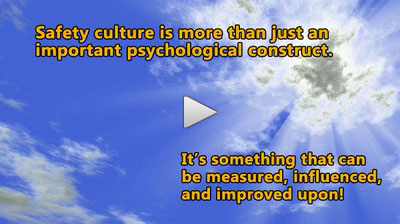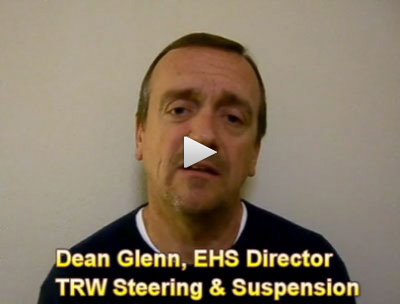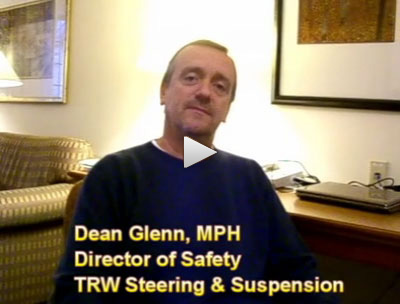Bridging The Human Performance Gap in Safety for More than 25 Years
Safety Leadership | Culture | Engagement | World-Class SafetySAFETY CULTURE SURVEY
Assessing Your Safety Climate and Safety Culture
Occupational health and safety concerns in the workplace continue to gain more interest but practical solutions are often lacking. And for many companies, their safety culture, or culture for safety is part of the foundation that most needs improvement. For many organizations, a safety culture survey can be used as part of a safety evaluation that relates directly to supervisory performance, morale, job satisfaction, and of course, productivity. We have a well validated safety culture survey tool available to help professionals intervene efficiently through practical forms of measurement — before injuries occur? Through our safety culture survey, we can efficiently assess your overall culture for safety. Some individuals might also refer to this type of evaluation as a safety culture assessment or a safety culture questionnaire. This type of safety strategy allows you to measure the “climate for safety” or employee perceptions regarding safety. More correctly, this part of a safety culture evaluation is a direct reflection of your overall culture for safety. And you should also know that our safety culture assessment process makes use of a very well validated safety culture survey tool, evaluated by an expert in survey test construction, development, and evaluation. That means you can trust your results and the research that supports our findings.

Organizational climate has been studied from as early as the 1940’s. In fact, climate is a good overall reflection of an organization’s culture. And climate has always been viewed as critical to the health of an organization. For example, how do employees feel about management’s support with regard to equipment? Do they feel they have the appropriate tools and training to do their jobs effectively and safely? Do they believe their supervisors offer appropriate safety support? We can measure you culture for safety in much the same way.

Often, employees will act the way they feel. If they believe management doesn’t really care about their health and well-being, productivity may suffer. Even more, it’s been shown that injuries and illnesses are worsened when workers don’t feel they’re being adequately supported by their supervisors or management. This means that delays in returning to work may follow and on-the-job performance will suffer. By measuring key areas critical to your safety climate, management can intervene in proactive ways to improve your overall health and safety efforts — your safety culture. This is a very efficient and cost-effective way to measure your safety culture for sustainable, long-term improvement.
 Measuring critical components of your safety culture you can improve your own programs and processes and help you develop a strategy for continuous safety improvement. A few key dimensions that would be measured include in our safety culture survey include: management support, coaching, supervisory support, training and tools and equipment. Results of your profile are gathered through safety questionnaires completed by the each level of your workforce, and summarized in various ways with recommendations. Deliverables include a very robust evaluation complete with graphs, tables, summaries, and great insights to improve your culture for safety in a very comprehensive manner. Our survey methodology often includes face-to-face interviews and safety focus group work with specific groups of your employees. In addition, our safety culture survey or safety climate questionnaire has been validated through decades of research and input which make it a powerful tool that you can rely upon.
Measuring critical components of your safety culture you can improve your own programs and processes and help you develop a strategy for continuous safety improvement. A few key dimensions that would be measured include in our safety culture survey include: management support, coaching, supervisory support, training and tools and equipment. Results of your profile are gathered through safety questionnaires completed by the each level of your workforce, and summarized in various ways with recommendations. Deliverables include a very robust evaluation complete with graphs, tables, summaries, and great insights to improve your culture for safety in a very comprehensive manner. Our survey methodology often includes face-to-face interviews and safety focus group work with specific groups of your employees. In addition, our safety culture survey or safety climate questionnaire has been validated through decades of research and input which make it a powerful tool that you can rely upon.
When you begin to measure areas like those addressed above, you can start to move ahead with a well thought out safety plan. This form of measurement will help to: 1) Increase management visibility and gain support; 2) reduce costs through more focused efforts; 3) form baselines for ongoing improvements; 4) increase safety accountability for supervisors and managers; and 5) improve employee relations by allowing workers to be “a greater part of the safety process.”
Measuring your climate for safety makes good business sense and can help move your organization in the right direction. By measuring key indicators, “before injuries occur,” you can make very good use of a proactive “up-stream” safety measure that can become integral to your long-term success!
Safety Culture
Assessing your culture for safety is no easy task without the proper knowledge, skills, and tools. These are essential points that need to be made. Understanding what people believe and understand, what they assume to be true, and what they value is a part of assessing the hidden barriers to achieving the kind of success you want and need. It’s also a part of engaging your leadership at various critical levels throughout your organization.
How can you better understand the key dimensions for improving your safety culture? How do you get to the deep seated beliefs and assumptions that are widely held by the people within your own organization? With a sound under-standing of culture and the critical aspects that make up your safety culture — it can be done and done very well. In this same regard, we can help. At David Sarkus International, we have the knowledge, skills, abilities, and the tools to move your organization forward, so that you can embrace the reality of World-Class Safety Performance!

Our safety culture survey, Safety Mirror Assess™ measures 11 key safety culture dimensions that will allow you to better understand your culture for safety and to create the kind sustainable results you want to achieve.
![]() Results of your organizational profile are gathered through questionnaires completed by all levels of your workforce, and summarized in various charts, graphs, and narratives that make for a very robust safety culture assessment. Employee sensing sessions are also often used to support findings captured through Safety Mirror Assess™.
Results of your organizational profile are gathered through questionnaires completed by all levels of your workforce, and summarized in various charts, graphs, and narratives that make for a very robust safety culture assessment. Employee sensing sessions are also often used to support findings captured through Safety Mirror Assess™.
When you begin to measure key cultural dimensions for safety, you can start to move ahead with a well thought out action plan. This will help you to:
- Increase organizational alignment and engagement;
- Reduce costs through more focused execution;
- Form baselines for ongoing improvements;
- Increase accountability for supervisors and managers; and
- Improve employee relations by allowing workers to be “part of a major
improvement process.
If you desire to improve your culture for safety it will help if you begin to ask a few very simple questions:
- Where are you now with regard to your culture for safety?
- From a strategic standpoint — where do you want to go?
- What are the gaps between “where you are now” and “where you want to go?”
- Do you have a plan to close these very important gaps?
If you need help answering these questions you’re not alone — we have the answers. Fundamentally, these questions provide the platform to understanding your safety culture, the inherent barriers to change, and the solutions that include a strategic plan for your future success in safety.
There are a number of ways to understand safety culture and we have a variety of tools and methods to help you better assess what’s going on. By working closely with you, we will personalize an approach that will best support your cultural safety variations as well as your goals and objectives.
Next: Behavior-Based Safety | Prev: Leadership & Coaching
